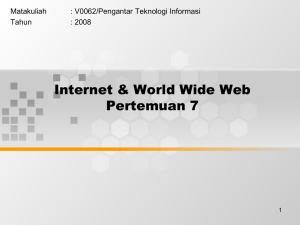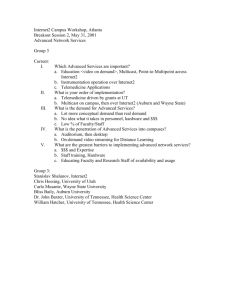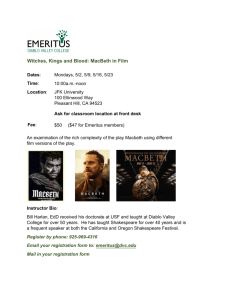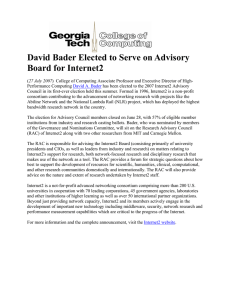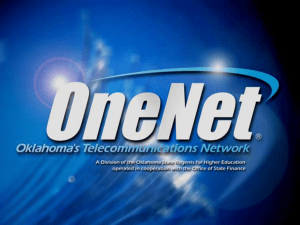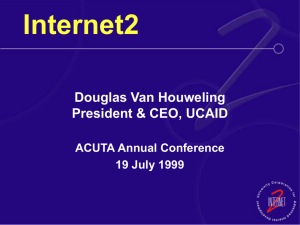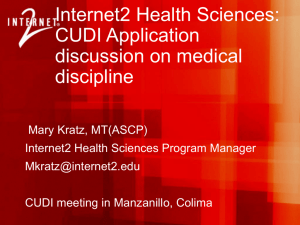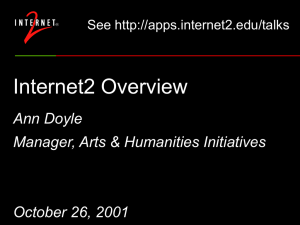A Social Transformation - The Millennium Project
advertisement
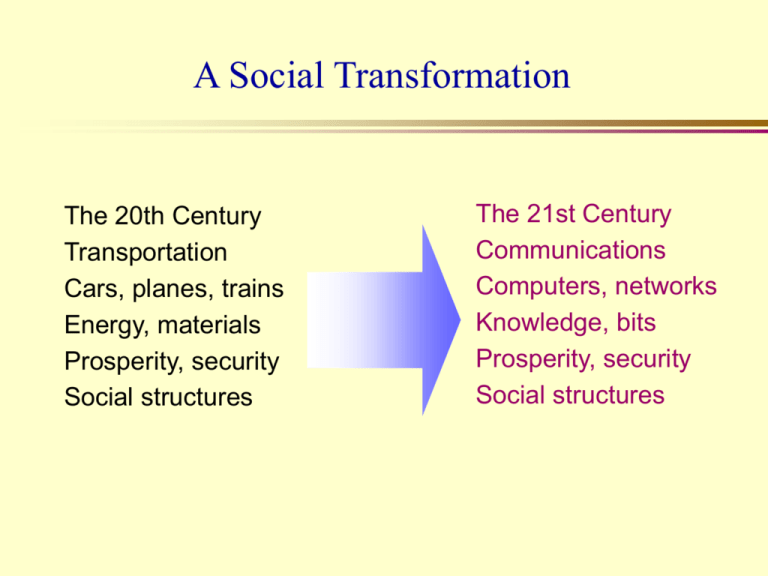
A Social Transformation The 20th Century Transportation Cars, planes, trains Energy, materials Prosperity, security Social structures The 21st Century Communications Computers, networks Knowledge, bits Prosperity, security Social structures Forces of Change A Changing World Age of Knowledge Demographic Change Globalization Post-Cold War World Spaceship Earth Forces on the University Economics Societal Needs Technology Markets Brave New World? Society of Learning? Some quotes... “Thirty years from now the big university campuses will be relics. Universities won’t survive. It is as large a change as when we first got the printed book.” – Peter Drucker “If you believe that an institution that has survived for a millennium cannot disappear in just a few decades, just ask yourself what has happened to the family farm.” – William Wulf “I wonder at times if we are not like the dinosaurs, looking up at the sky at the approaching comet and wondering whether it has an implication for our future.” – Frank Rhodes NAS/NAE/IOM/NRC Study The Impact of Information Technology on the Future of the Research University Information Technology and the Future of the Research University Premise: Rapidly evolving information technology poses great challenges and opportunities to higher education in general and the research university in particular. Yet many of the key issues do not yet seem to be on the radar scope of either university leaders or federal research agencies. Phase One Technology scanning (a decade out) Implications for the future of the research university Possible roles for federal government and other stakeholders ITFRU Guidance Committee James Duderstadt (Chair), President Emeritus, Univesity of Michigan Daniel Atkins, Professor of Information and Computer Science, University of Michigan John Seely Brown, Chief Scientist, Xerox PARC Marye Anne Fox, Chancellor, North Carolina State University Ralph Gomory, President, Alfred P. Sloan Foundation Nils Hasselmo, President, Association of American Universities Paul Horn, Senior Vice President for Research, IBM Shirley Ann Jackson, President, Rensselaer Polytechnic Institute Frank Rhodes, President Emeritus, Cornell University Marshall Smith, Professor of Education, Stanford; Program Officer, Hewlett Foundation Lee Sproull, Professor of Business Administration, NYU Doug Van Houweling, President and CEO, UCAIC/Internet2 Robert Weisbuch, President, Woodrow Wilson National Fellowship Foundation William Wulf, President, National Academy of Engineering Joe B. Wyatt, Chancellor Emeritus, Vanderbilt University Raymond E. Fornes (Study staff), Professor of Physics, North Carolina State University Phase 1: Conclusions There was a consensus that the extraordinary evolutionary pace of information technology is likely to continue for the next several decades and even could accelerate on a superexponential slope. The event horizons for disruptive change are moving ever closer. There are likely to be major technology surprises, comparable in significance to the appearance of the personal computer in the 1970s and the Internet browser in 1994, but at more frequent intervals. The future is becoming less certain. From Eniac To ASCI "Q" … and beyond ASCI Purple (2004): 100 TeraFlops IBM Blue Gene L (2004): 360 TeraFlops IBM Blue Gene P (2006): “Several” PetaFlops The Evolution of Computing 1y Doubling Time 1.5 y 2y Hardware Technology Trends Processing (Moore's Law) (increasing 40% per year) Current speed record: 150 GHz chips Disk storage (increasing 60% to 100% per year) 3.5 disk can hold 320 Gb Far cheaper than paper or microfilm Bandwidth Lab demo on single fiber: 11 Tb/s Real communication at 40 Gb/s Mobility 802.11 (a, b, g, I) at 55 Mb/s and beyond Displays Full wall projections Resolution much better than paper Software and System Trends Algorithm improvements Embodiment of techniques and processes into software Formalization and standardization People are the exception rather than the main line Distribution of computing, data, applications, and services Grid interconnection of resources Services as unit of IT, rather than bare-bones data and processing Some Examples Speed MHz to GHz to THz to Peta Hz Memory MB (RAM) to GB (CD,DVD) to TB (holographic) Bandwidth Kb/s (modem) to Mb/s (Ethernet) to Gb/s Internet2 to Grid to National LambaRail Networks Copper to fiber to wireless to photonics “Fiber to the forehead…” Computer-Mediated Human Interaction 1-D (words) Text, e-mail, chatrooms, IM, telephony 2-D (images) Graphics, video, WWW, multimedia 3-D (environments) Virtual reality Virtual worlds And beyond… (experiences, “sim-stim”) Telepresence Neural implants An Example: Evolution of the Net Already beyond human comprehension Incorporates ideas and mediates interactions among millions of people 500 million today; more than 1 billion in 2010 Internet2, National Lamba Rail, TeraGrid Semantic Web, Executable Internet, Web Services, Cyberinfrastructure Conclusions (continued) The impact of information technology on the university will likely be profound, rapid, and discontinuous–just as it has been and will continue to be for the economy, our society, and our social institutions (e.g., corporations, governments, and learning institutions It will affect our activities (teaching, research, outreach), our organization (academic structure, faculty culture, financing and management), and the broader higher education enterprise as it evolves into a global knowledge and learning industry. Information technology is a disruptive technology in higher education that requires strategic attention. IT and the University Missions: teaching, research, service? Alternative: Creating, preserving, integrating, transferring, and applying knowledge. The University: A “knowledge server”, providing knowledge services in whatever form is needed by society. Note: The fundamental knowledge roles of the university have not changed over time, but their realizations certainly have. Research Simulating reality Collaboratories: the virtual laboratory Changing nature of research Disciplinary to interdisciplinary Individual to team “Small think” to “big think” Analysis to creativity Tools: materials, lifeforms, intelligences Law, business, medicine to art, architecture, engineering Libraries Books to bytes (atoms to bits) Acquiring knowledge to navigating knowledge What is a book? A portal to the knowledge of the world. Teaching to Learning Pedagogy Lecture hall to environment for interactive, collaborative learning Faculty to designer, coach Classroom Handicraft to commodity Learning communities Virtual, distributed environments Open learning Teacher-centered to learner-centered Passive Student to Active Learner to Demanding Consumer Unleashing the power of the marketplace The Plug and Play Generation Raised in a media-rich environment Sesame Street, Nintendo, MTV, Home computers, WWW, MOOs, virtual reality Learn through participation and experimentation Learn through collaboration and interaction Nonlinear thinking, parallel processing Conclusions (continued) Yet, for at least the near term, meaning a decade or less, the university will continue to exist in much its present form, although meeting the challenge of emerging competitors in the marketplace will demand significant changes in how we teach, how we conduct scholarship, and how our institutions are financed. Universities must anticipate these forces, develop appropriate strategies, and make adequate investments if they are to prosper during this period. Procrastination and inaction are the most dangerous courses of all during a time of rapid technological change. Conclusions (continued) Because of the profound yet unpredictable impact of this technology, it is important that institutional strategies include: the opportunity for experimentation, the formation of alliances both with other academic institutions as well as with for-profit and government organizations, and the development of sufficient in-house expertise among the faculty and staff to track technological trends and assess various courses of action.
